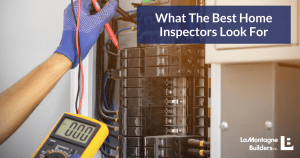What the Best Home Inspectors Look For, and You Should Too

Find out how old the roof is. Deteriorated shingles and damp or rotted materials under the shingles are a sign of needed repairs. Look for water stains across the ceilings or down the walls inside the house for evidence of potential leaks. Find out if the current homeowner’s roof warranty will transfer to you with the purchase.
If there’s a fireplace, the home inspector should look closely at the chimney, to make sure it’s in working order. That means making sure there’s no damage inside the lining, that the bricks and mortar are in good condition, and the base is watertight.
Test the plumbing simply by running the faucets and flushing the toilets. You can make note of any problems with water pressure and see if the drains are clogged. Take a look at the pipes under the sinks and watch for any leaks.
Water damage on the walls, ceiling, or floors is a signal that something could be wrong. It might be from a leaky roof, or it might be something else. Discoloration could be caused by a problem inside the walls. You’ll want to ask the owners if any problems were addressed. You certainly don’t want to deal with mold down the road.
The foundation can be a tricky area to spot problems, but it shouldn’t be ignored. There are some things you can watch for, such as uneven and drywall cracks, or doors or windows that stick or don’t latch properly, these could also be signs of foundational problems.
Leaks from the foundation can lead to mold and a mildew odor in the basement. Leaks are usually the result of poor drainage outside the house. Check the gutters and spouts to make sure rainwater is flowing away from the foundation.
Your inspector will be able to assess that the home’s furnace and air conditioning unit are working, but can’t guarantee how long they’ll continue to function once you move in. But knowing the age of those pricey appliances will give you a pretty good idea. A furnace with regular maintenance can last more than 20 years, and an AC condenser about 15.
In older homes — those built before 1978 — asbestos and lead paint remain potential health hazards. An experienced home inspector will be able to notice disturbed asbestos fibers, and a lead paint testing company might be worth a call to properly identify areas where lead needs to be removed.
There’s a lot to think about when inspecting a home! We haven’t even addressed previous renovations of older homes that could raise a host of other problems if you decide to take on a remodeling project of your own. Those home improvement reality shows are always revealing structural issues and surprises for the unsuspecting owners who had no idea what was lurking behind the walls.
But when you buy a new construction home, everything used to build it is brand new and meets the current requirements for codes and standards. You can rest comfortably in your new home with warranties in place on important elements like your heating system, water heater, and roof, among others. The home is inspected and approved before you move in. Ready to see what we have to offer? See what communities we have available and take a virtual tour!